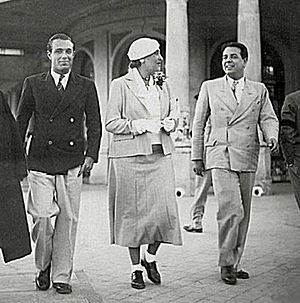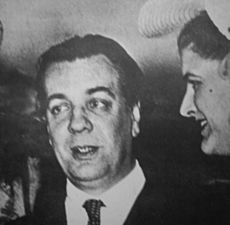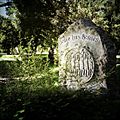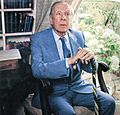Jorge Luis Borges facts for kids
Quick facts for kids
Jorge Luis Borges
|
|
|---|---|

Borges in 1951
|
|
| Born | Jorge Francisco Isidoro Luis Borges Acevedo 24 August 1899 Buenos Aires, Argentina |
| Died | 14 June 1986 (aged 86) Geneva, Switzerland |
| Occupation |
|
| Language | Spanish |
| Notable works |
|
| Notable awards | Commandeur de l'Ordre des Arts et des Lettres (1962) |
| Relatives |
|
|
|
|
| Signature |  |
Jorge Francisco Isidoro Luis Borges Acevedo (24 August 1899 – 14 June 1986) was an Argentine short-story writer, essayist, poet and translator, and a key figure in Spanish-language literature. His best-known books, Ficciones (Fictions) and El Aleph (The Aleph), published in the 1940s, are short stories interconnected by common themes, including dreams, labyrinths, philosophy, libraries, mirrors, fictional writers, and mythology. Borges' works have contributed to philosophical literature and the fantasy genre, and have been considered by some critics to mark the beginning of the magic realist movement in 20th century Latin American literature.
In 1961, he came to international attention when he received the first Formentor prize (Prix International). In 1971, he won the Jerusalem Prize. He dedicated his final work, The Conspirators, to the city of Geneva, Switzerland. He was influenced by authors such as Dante Alighieri, Miguel de Cervantes, Franz Kafka, H.G. Wells, Rudyard Kipling, Arthur Schopenhauer and G. K. Chesterton.
Early life
Jorge Francisco Isidoro Luis Borges Acevedo was born into an educated middle-class family on 24 August 1899. They were in comfortable circumstances but not wealthy enough to live in downtown Buenos Aires so the family resided in Palermo, then a poorer neighbourhood. Borges's mother, Leonor Acevedo Suárez, came from a traditional Uruguayan family of criollo (Spanish) origin. Her family had been much involved in the European settling of South America and the Argentine War of Independence, and she spoke often of their heroic actions.
Aged ten, Jorge Luis Borges translated Oscar Wilde's The Happy Prince into Spanish. It was published in a local journal, but Borges's friends thought the real author was his father. Borges Haslam was a lawyer and psychology teacher who harboured literary aspirations. Borges said his father "tried to become a writer and failed in the attempt". Jorge Luis Borges wrote, "as most of my people had been soldiers and I knew I would never be, I felt ashamed, quite early, to be a bookish kind of person and not a man of action."
Jorge Luis Borges was taught at home until the age of 11, was bilingual in Spanish and English, reading Shakespeare in the latter at the age of twelve. The family lived in a large house with an English library of over one thousand volumes; Borges would later remark that "if I were asked to name the chief event in my life, I should say my father's library."
His father gave up practicing law due to the failing eyesight that would eventually affect his son. In 1914, the family moved to Geneva, Switzerland, and spent the next decade in Europe. In Geneva, Borges Haslam was treated by an eye specialist, while his son and daughter attended school. Jorge Luis learned French, read Thomas Carlyle in English, and began to read philosophy in German. In 1917, when he was eighteen, he met writer Maurice Abramowicz and began a literary friendship that would last for the remainder of his life. He received his baccalauréat from the Collège de Genève in 1918. The Borges family decided that, due to political unrest in Argentina, they would remain in Switzerland during the war. After World War I, the family spent three years living in various cities: Lugano, Barcelona, Majorca, Seville, and Madrid. They remained in Europe until 1921.
Literary career
In 1921, Borges returned with his family to Buenos Aires. In 1923, he first published his poetry, a collection called Fervor de Buenos Aires.
From the first issue, Borges was a regular contributor to Sur, founded in 1931 by Victoria Ocampo. It was then Argentina's most important literary journal and helped Borges find his fame. Ocampo introduced Borges to Adolfo Bioy Casares, another well-known figure of Argentine literature who was to become a frequent collaborator and close friend. They wrote a number of works together, some under the nom de plume H. Bustos Domecq, including a parody detective series and fantasy stories.
In 1933, Borges gained an editorial appointment at Revista Multicolor de los Sábados (the literary supplement of the Buenos Aires newspaper Crítica), where he first published the pieces collected as Historia universal de la infamia (A Universal History of Infamy) in 1935. The book includes two types of writing: the first lies somewhere between non-fiction essays and short stories, using fictional techniques to tell essentially true stories. The second consists of literary forgeries, which Borges initially passed off as translations of passages from famous but seldom-read works.
In the following years, he served as a literary adviser for the publishing house Emecé Editores, and from 1936 to 1939 wrote weekly columns for El Hogar. In 1938, Borges found work as the first assistant at the Miguel Cané Municipal Library. It was in a working-class area and there were so few books that cataloging more than one hundred books per day, he was told, would leave little to do for the other staff and would make them look bad. The task took him about an hour each day and the rest of his time he spent in the basement of the library, writing and translating.
In 1938, Borges had a severe head injury; during treatment, he nearly died of sepsis. While recovering from the accident, Borges began exploring a new style of writing for which he would become famous. His first story written after his accident, "Pierre Menard, Author of the Quixote," came out in May 1939. One of his most famous works, "Menard" examines the nature of authorship, as well as the relationship between an author and his historical context. His first collection of short stories, El jardín de senderos que se bifurcan (The Garden of Forking Paths), appeared in 1941, composed mostly of works previously published in Sur.
Composed of stories taking up over sixty pages, the book was generally well received, but El jardín de senderos que se bifurcan failed to garner for him the literary prizes many in his circle expected.
With his vision beginning to fade in his early thirties and unable to support himself as a writer, Borges began a new career as a public lecturer. Around this time, Borges also began writing screenplays.
In 1955, he became director of the Argentine National Library. By the late 1950s he had become completely blind.
His later collection of poetry, Elogio de la Sombra (In Praise of Darkness), develops this theme. In 1956 the University of Cuyo awarded Borges the first of many honorary doctorates and the following year he received the National Prize for Literature. From 1956 to 1970, Borges also held a position as a professor of literature at the University of Buenos Aires and other temporary appointments at other universities. He was knighted by Queen Elizabeth II in 1964. In the fall of 1967 and spring of 1968, he delivered the Charles Eliot Norton Lectures at Harvard University.
As his eyesight deteriorated, Borges relied increasingly on his mother's help. When he was not able to read and write anymore (he never learned to read Braille), his mother, to whom he had always been close, became his personal secretary. When Perón returned from exile and was re-elected president in 1973, Borges immediately resigned as director of the National Library.
In 1961, Borges received the first Prix International, which he shared with Samuel Beckett. While Beckett had garnered a distinguished reputation in Europe and America, Borges had been largely unknown and untranslated in the English-speaking world and the prize stirred great interest in his work.
In 1967, Borges began a five-year period of collaboration with the American translator Norman Thomas di Giovanni, through whom he became better known in the English-speaking world. Di Giovanni contended that Borges's popularity was due to his writing with multiple languages in mind and deliberately using Latin words as a bridge from Spanish to English.
Borges continued to publish books, among them El libro de los seres imaginarios (Book of Imaginary Beings, 1967, co-written with Margarita Guerrero), El informe de Brodie (Dr. Brodie's Report, 1970), and El libro de arena (The Book of Sand, 1975). He lectured prolifically.
From 1975 until the time of his death, Borges traveled internationally. He was often accompanied in these travels by his personal assistant María Kodama, an Argentine woman of Japanese and German ancestry. In April 1986, a few months before his death, he married her via an attorney in Paraguay.
Death
Borges died of liver cancer on 14 June 1986, aged 86, in Geneva. His burial was preceded by an service at the Protestant Cathédrale de Saint Pierre on 18 June. With many Swiss and Argentine dignitaries present. After the funeral, Borges was laid to rest in Geneva's Cimetière de Plainpalais. His grave, marked by a rough-hewn headstone, is adorned with carvings derived from Anglo-Saxon and Old Norse art and literature.
Works
Some literary critics argue that Borges may have been the most important figure in Spanish-language literature since Cervantes.
In addition to short stories for which he is most noted, Borges also wrote poetry, essays, screenplays, literary criticism, and edited numerous anthologies. His longest work of fiction is a fourteen-page story, "The Congress", first published in 1971.
Paramount among his intellectual interests are elements of mythology, mathematics, theology, integrating these through literature, sometimes playfully, sometimes with great seriousness.
As his eyesight waned, he increasingly focused on writing poetry, since he could memorize an entire work in progress.
His poems embrace the same wide range of interests as his fiction.
Borges was a notable translator. He translated works of literature in English, French, German, Old English, and Old Norse into Spanish. He translated (while simultaneously subtly transforming) the works of, among others, Ambrose Bierce, William Faulkner, André Gide, Hermann Hesse, Franz Kafka, Rudyard Kipling, Edgar Allan Poe, Walt Whitman, and Virginia Woolf. Borges wrote and lectured extensively on the art of translation.
Images for kids
-
María Kodama at the 2010 Frankfurt Book Fair
-
Monument in Buenos Aires
-
Monument in Lisbon
See also
 In Spanish: Jorge Luis Borges para niños
In Spanish: Jorge Luis Borges para niños












